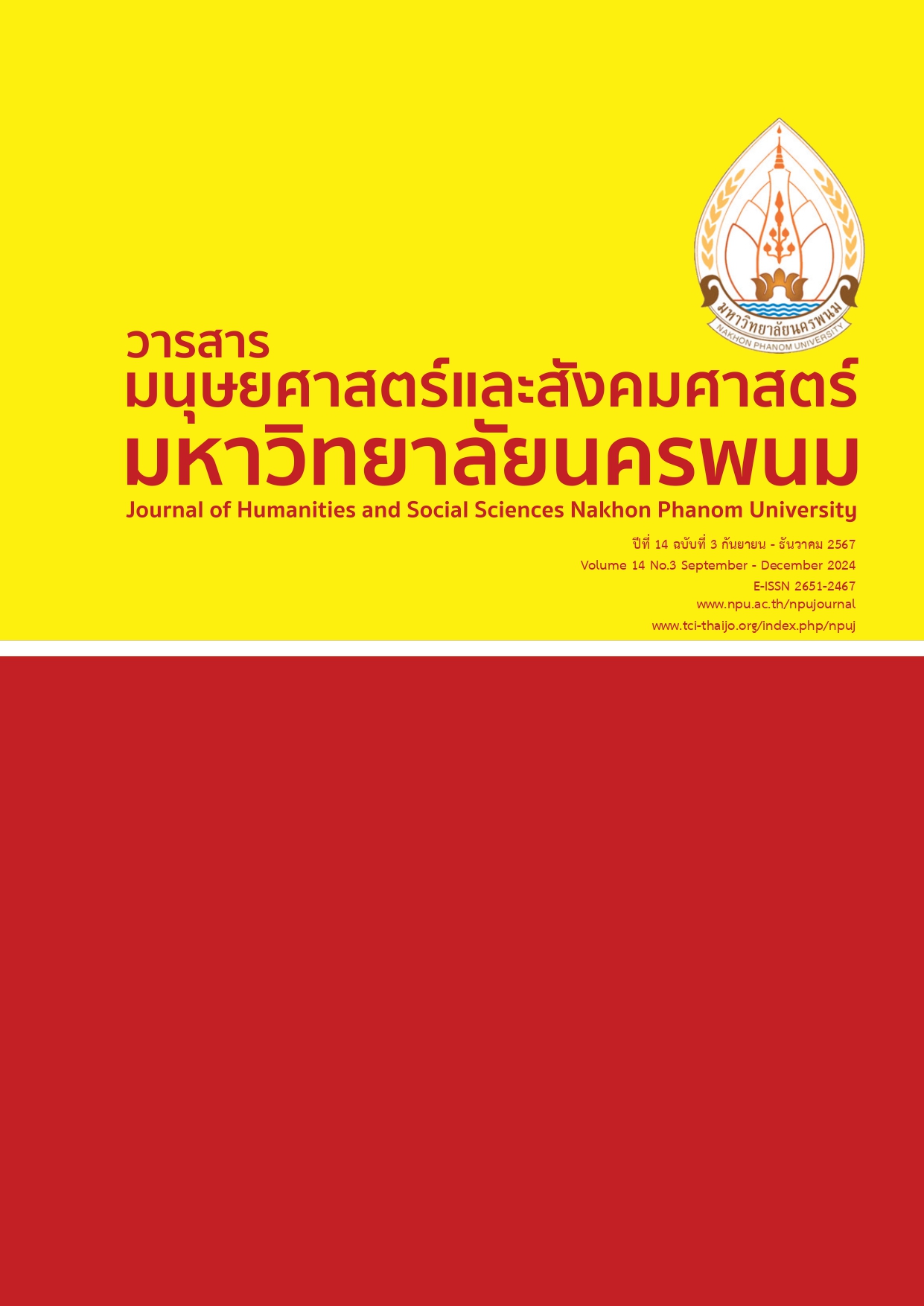การสำรวจภูมิทัศน์สื่อสังคมออนไลน์ประเด็นบุหรี่ไฟฟ้าเพื่อกำหนดแนวทางการสื่อสารส่งเสริมการพัฒนาที่ยั่งยืน เป้าหมายที่ 3 – มีสุขภาพและความเป็นอยู่ที่ดี
Main Article Content
บทคัดย่อ
การวิจัยครั้งนี้มีวัตถุประสงค์เพื่อศึกษาปริมาณข้อมูลเกี่ยวกับบุหรี่ไฟฟ้าในพื้นที่สื่อสังคมออนไลน์ต่างๆ ประเภทของผู้ส่งสารข้อมูลเกี่ยวกับบุหรี่ไฟฟ้า และประเด็นเนื้อหาข้อมูลเกี่ยวกับบุหรี่ไฟฟ้าในพื้นที่สื่อสังคมออนไลน์ โดยใช้เทคนิคการวิจัยแบบ Computational Social Science ประชากรของการวิจัยคือ ข้อมูลเกี่ยวกับบุหรี่ไฟฟ้าที่ได้จากการค้นหาผ่านเครื่องมือ Social Listening Tools ได้แก่ Google Trends, Mandala Analytics และการทำ Web Scraping เก็บรวบรวมข้อมูลโดยใช้คีย์เวิร์ดในการค้นหา คือ “บุหรี่ไฟฟ้า” ในสื่อสังคมออนไลน์ ได้แก่ Facebook, X, Community blogs, E-commerce Website และเว็บไซต์ต่างๆ และวิเคราะห์ข้อมูลด้วยการวิเคราะห์เนื้อหา ผลการวิจัยพบว่า 1) มีปริมาณสื่อสารเกี่ยวข้องกับบุหรี่ไฟฟ้าในทุกช่องทางสื่อสังคมออนไลน์ โดยมีปริมาณการค้นหาสัมพันธ์สูงที่สุดใน พ.ศ.2565 จำนวน 100 หน่วย การค้นหาสัมพันธ์ 2) ประเภทของผู้ส่งสารเกี่ยวกับบุหรี่ไฟฟ้า พบว่า กลุ่มผู้ขายบุหรี่ไฟฟ้ามีปริมาณมากกว่า กลุ่มรณรงค์เรื่องบุหรี่ไฟฟ้า และสำนักข่าวต่างๆ 3) เนื้อหาข้อมูลเกี่ยวกับบุหรี่ไฟฟ้าผ่านสื่อสังคมออนไลน์ สามารถแบ่งได้เป็นเนื้อหาเกี่ยวกับความต้องการเนื้อหาข้อมูลเกี่ยวกับการสูบบุหรี่ไฟฟ้า และเนื้อหาเกี่ยวกับความต้องการเนื้อหากฎหมายที่เกี่ยวข้องกับการสูบบุหรี่ไฟฟ้า ผลการวิจัยจะช่วยให้องค์กรขับเคลื่อนสังคมด้านบุหรี่ไฟฟ้าได้เข้าใจบริบท เป็นข้อมูลพื้นฐานในการสื่อสาร กำหนดนโยบาย พร้อมแนวทางการสื่อสารส่งเสริมการพัฒนาที่ยั่งยืน(Sustainable Development Goals–SDGs) เป้าหมายที่ 3 – มีสุขภาพและความเป็นอยู่ที่ดี (Good Health and Well-being)
Article Details

This work is licensed under a Creative Commons Attribution-NonCommercial-NoDerivatives 4.0 International License.
References
Akharawirawat, T. & Banchonhattakit, P. (2022). Health Communication for Health Promotion in Community. Journal of Phrae Public Health for Development (JPPHD), 2(1),78-89.
Chacon, L., Mitchell, G. & Golder, S. (2024).The commercial promotion of electronic cigarettes on social media and its influence on positive perceptions of vaping and vaping behaviours in Anglophone countries:A scoping review.PLOS Global Public Health, 4(1),e0002736. doi:org/10.1371/journal.pgph. 0002736
Chen, J. & Wang, Y. (2021). Social media use for health purposes: systematic review. Journal of medical Internet research, 23(5),e17917. doi:10.2196/17917
Clendennen, S. L., Loukas, A., Vandewater, E. A., Perry, C. L. & Wilkinson, A. V. (2020). Exposure and engagement with tobacco-related social media and associations with subsequent tobacco use among young adults: A longitudinal analysis. Drug & Alcohol Dependence, 213,108072.doi:org/10. 1016/j.drugalcdep.2020.108072.
Ducange, P., Fazzolari, M., Petrocchi, M. & Vecchio, M. (2019). An effective decision support system for social media listening based on cross-source sentiment analysis models.Engineering Applications of Artificial Intelligence, 78(2019),71-85. doi:10.1016/j.engappai.2018.10.014
Goicoechea, J. Z., Boughner, A., Lee, J. J. C., Mahajan, A., Yeo, K., Sproga, M. & Polosa, R. (2024). A global health survey of people who vape but never smoked: protocol for the VERITAS (Vaping Effects: Real-World International Surveillance) Study. JMIR Research Protocols.13(1),e54236.doi:10.2196 /54236
Grønmo, S. (2019). Social research methods: Qualitative, Quantitative and Mixed Methods Approaches. America : SAGE Publications.
Hfocus. (2024). TRC reveals severe e-cigarette epidemic among children! research shows 66.7% buy from online stores. Retrieved June 2024, from https://www.hfocus.org/content/2024/03/30074
Lyu, J. C., Huang, P., Jiang, N. & Ling, P. M. (2022). A systematic review of e-cigarette marketing communication: messages, communication channels, and strategies. International Journal of Environmental Research and Public Health, 19(15),9263. doi:org/10.3390/ijerph19159263.
Kaewthet, T. (2022).Creating Content on New Media Landscape in The Digital Age. Lampang Rajabhat University Journal, 11(2),92-102.
Kong G., Kuguru E. K., Bhatti H., Sen, I. & Morean E.M. (2021). Marketing Content on E-Cigarette Brand-Sponsored Facebook Profile Pages. Subst Use Misuse, 56(4),442-448. doi:10.1080/10826084.2021. 1878223
Kotler, P. & Keller K. L. (2016). Marketing management (15th ed.). Harlow : Pearson Education Limited.
Lee, S., Elam, K., Lohrmann, D., Luo, J., Chow, A. & Seo, D. C. (2024). Prospective longitudinal relations among frequent social media use, nicotine vaping and experiencing internalizing mental health problems. Addiction. 119(10),1751-1761. doi:10.1111/add.16601
Lohapiratana, K. (2022). 9 Social Listening Tools with Powerful Features – Both Free and Paid [Full Review!!]. Retrieved October 2024, from https://contentshifu.com/blog/review-social-listening-tools
Loysmut, S. (2020). Government as Enemy: A Discourse Analysis Approach in Social Media and Newspaper Articles Regarding E-Cigarette Control. Public Health Policy and Laws Journal, 6(1),201-201.
Maneekun, C. (2023). Factors related to early electric smoking stage among upper secondary school students in chachoengsao province. Retrieved October 2024, from https://ir.buu.ac.th/dspace /bitstream/1513/841/1/63910211.pdf
National Statistical Office Thailand. (2021). Health Behavior of Population Survey. Retrieved June 2024, from https://www.nso.go.th/nsoweb/nso/survey_detail/w6
Rohde, J. A., Noar, S. M., Mendel, J. R., Hall, M. G., Baig, S. A., Ribisl, K. M. & Brewer, N. T. (2020). E-Cigarette health harm awareness and discouragement: implications for health communication. Nicotine and Tobacco Research. 22(7),1131-1138. doi:10.1093/ntr/ntz194.
Singh, T., Agaku, I. T., Arrazola, R. A., Marynak, K. L., Neff, L. J., Rolle, I. T. & King, B. A. (2016). Exposure to advertisements and electronic cigarette use among US middle and high school students. Pediatrics, 137(5),1-9. doI:10.1542/peds.2015-4155.
Simon K. (2023). Digital 2023: Thailand (The state of digital in Thailand in 2023). Retrieved June 2024, from https://datareportal.com/reports/digital-2023-thailand.
Sloan, L., & Quan-Haase, A. (2022). The SAGE handbook of social media research methods. London : Sage Publications Ltd.
The Coverage. (2023). HSS reveals e-cigarette smoking rates among 'youth' in 6 health regions higher than national level, 92%influenced by friends. Retrieved July 2024, from https://www.thecoverage. info/news/content/5099
Vogel, E. A., Ramo, D. E., Rubinstein, M. L., Delucchi, K. L., Darrow, S. M., Costello, C. & Prochaska, J. J. (2021). Effects of social media on adolescents’ willingness and intention to use e-cigarettes: An experimen tal investigation. Nicotine & Tobacco Research, 23(4),694–701. doi:10.1093/ntr/ntaa003
Yang, Q. (2024). Understanding the associations between adolescents’ exposure to e-cigarette information and vaping behavior through the theory of planned behavior. Health Communication, 39(4),641-651. doi:10.1080/10410236.2023.2179715
Yavuz, Ş. & Tire, E. (2023). A survey of corporate communication professionals' perspective on social listening and analytics. Corporate Communications: An International Journal, 28(4),564-581.doi:10.1108 /CCIJ-03-2022-0036
Zhang, L., Ao, S. H., Ye, J. F. & Zhao, X. (2024). How does health communication on social media influence e-cigarette perception and use? A trend analysis from 2017 to 2020. Addictive Behaviors, 149,107875. doi:10.1016/j.addbeh.2023.107875

